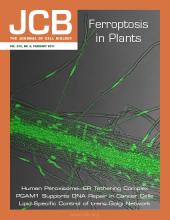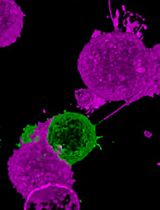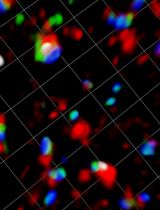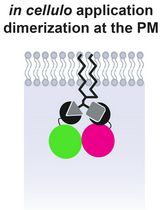- EN - English
- CN - 中文
Peroxisome Motility Measurement and Quantification Assay
过氧化物酶体能动性测量和定量分析
发布: 2017年09月05日第7卷第17期 DOI: 10.21769/BioProtoc.2536 浏览次数: 8230
评审: Pengpeng LiThirupugal GovindarajanAnonymous reviewer(s)
Abstract
Organelle movement, distribution and interaction contribute to the organisation of the eukaryotic cell. Peroxisomes are multifunctional organelles which contribute to cellular lipid metabolism and ROS homeostasis. They distribute uniformly in mammalian cells and move along microtubules via kinesin and dynein motors. Their metabolic cooperation with mitochondria and the endoplasmic reticulum (ER) is essential for the β-oxidation of fatty acids and the synthesis of myelin lipids and polyunsaturated fatty acids. A key assay to assess peroxisome motility in mammalian cells is the expression of a fluorescent fusion protein with a peroxisomal targeting signal (e.g., GFP-PTS1), which targets the peroxisomal matrix and allows live-cell imaging of peroxisomes. Here, we first present a protocol for the transfection of cultured mammalian cells with the peroxisomal marker EGFP-SKL to observe peroxisomes in living cells. This approach has revealed different motile behaviour of peroxisomes and novel insight into peroxisomal membrane dynamics (Rapp et al., 1996; Wiemer et al., 1997; Schrader et al., 2000). We then present a protocol which combines the live-cell approach with peroxisome motility measurements and quantification of peroxisome dynamics in mammalian cells. More recently, we used this approach to demonstrate that peroxisome motility and displacement is increased when a molecular tether, which associates peroxisomes with the ER, is lost (Costello et al., 2017b). Silencing of the peroxisomal acyl-CoA binding domain protein ACBD5, which interacts with ER-localised VAPB, increased peroxisome movement in skin fibroblasts, indicating that membrane contact sites can modulate organelle distribution and motility. The protocols described can be adapted to other cell types and organelles to measure and quantify organelle movement under different experimental conditions.
Keywords: Peroxisome motility (过氧化物酶体动力学)Background
An important feature of eukaryotic cells is the presence of membrane-bound compartments (organelles), which create distinct optimised environments to promote various metabolic reactions required to sustain life. For the entire cell to function as a unit, coordination and cooperation between specialized organelles must take place. This requires a dynamic spatial organization, which allows the movement of organelles to areas of greatest metabolic need, the positioning of organelles in those areas, and the interaction with other compartments, which permits metabolic cooperation and communication amongst organelles. This is often mediated through interorganellar membrane contacts, whereby two organelles come into close apposition (Prinz, 2014; Eisenberg-Bord et al., 2016).
Peroxisomes are multifunctional organelles that play pivotal cooperative roles in the metabolism of cellular lipids and reactive oxygen species (ROS) and are thus essential for human health and development (Islinger and Schrader, 2011; Wanders et al., 2015; Waterham et al., 2016). Peroxisomes interact with many organelles involved in cellular lipid metabolism such as the endoplasmic reticulum (ER), mitochondria, lipid droplets or lysosomes (Schrader et al., 2013 and 2015). We revealed that the peroxisomal tail-anchored membrane proteins ACBD5 and ACBD4 directly interact with tail-anchored VAPB at the ER (Costello et al., 2017a; 2017b and 2017c). This interaction links both organelles together and allows transfer of lipids between them (Costello et al., 2017b; Hua et al., 2017). Whereas in plants and yeast, peroxisomes move along the actin cytoskeleton by interacting with myosin motors (Jedd and Chua, 2002; Fagarasanu et al., 2009), in mammalian cells (and filamentous fungi), peroxisomes use microtubules and dynein/kinesin motors to distribute uniformly within the cell and to reach new neighbourhoods (Schrader et al., 1996 and 2003; Guimaraes et al., 2015; Lin et al., 2016). We also found that ACBD5-VAPB interaction, which tethers peroxisomes to the ER, influences peroxisome motility (Costello et al., 2017b). Using the peroxisome motility measurement and quantification assay, we showed that loss of ACBD5, which resulted in reduced peroxisome-ER association, also increased peroxisome movement (Costello et al., 2017b). Our data indicate that organelle contact sites can modulate peroxisome (organelle) distribution and motility.
Peroxisomes are highly versatile organelles, which respond to environmental stimuli with changes in their number, size, and enzyme composition (Islinger et al., 2010). Certain stress conditions, in particular in plants, can lead to changes in the motile behaviour of peroxisomes and altered distribution (Rodríguez-Serrano et al., 2009). There is currently great interest in the measurement of peroxisome (organelle) motility and its quantification in order to understand the fundamental principles of organelle distribution, its regulation and role in organelle interaction and metabolic cooperation. Understanding these mechanisms is not just important for comprehending fundamental physiological processes but also for understanding pathogenic processes in disease etiology (Ferdinandusse et al., 2017; Yagita et al., 2017).
Materials and Reagents
- 10 cm culture dishes (Greiner Bio One International, catalog number: 664160 )
- Microporation tips
- 15 ml centrifuge tubes (Greiner Bio One International, catalog number: 188271 )
- 1.5 ml microcentrifuge tubes (Greiner Bio One International, catalog number: 616201 )
- 3.5 cm round glass bottom dishes (Cellview, Greiner Bio One International, catalog number: 627861 )
- Serological pipettes, 10 ml (Greiner Bio One International, catalog number: 607180 )
- Mammalian cell line of interest, here: human skin fibroblasts (see Note 1)
- Peroxisome marker (fluorescent reporter with a C-terminal peroxisomal targeting signal, e.g., EGFP-SKL plasmid [Schrader et al., 2000])
- Optional: siRNA for silencing of candidate genes/proteins in mammalian cells, here: ACBD5 (Ambion, catalog number: s40666 ); control scrambled siRNA (GE Healthcare Dharmacon, catalog number: D-001206-14-05 ) (50-100 µM stock) (in sterile, RNase/DNase-free water or buffer supplied by manufacturer)
- 70% (v/v) ethanol
- TrypLETM Express solution (1x) (Thermo Fisher Scientific, GibcoTM, catalog number: 12604013 ) (store at 4 °C)
- Immersion oil (Olympus, catalog number: IMMOIL-F30CC )
- Dulbecco’s modified Eagle medium (DMEM) high glucose (4.5 g/L) (Thermo Fisher Scientific, GibcoTM, catalog number: 11965092 ) for complete growth medium for cell culture of human skin fibroblasts
- Fetal bovine serum (FBS) (Thermo Fisher Scientific, GibcoTM, catalog number: 10082147 )
- Penicillin/streptomycin solution (Thermo Fisher Scientific, GibcoTM, catalog number: 15140122 )
- Sodium chloride (NaCl)
- Potassium chloride (KCl)
- Sodium phosphate dibasic (Na2HPO4)
- Potassium phosphate dibasic (K2HPO4)
- Complete growth medium for cell culture of human skin fibroblasts (see Recipes)
- Phosphate-buffered saline (1x PBS) (see Recipes)
Equipment
- Pipetting aid (Greiner Bio One International, model: Sapphire MAXIPETTE, catalog number: 847070 )
- Class II biological safety cabinet/tissue culture hood (Faster, model: SafeFAST Top 209-D, catalog number: F00000050000 ) (see Note 2)
- Humidified CO2 incubator (95% air, 5% CO2, 37 °C) (Thermo Fisher Scientific, Thermo ScientificTM, model: HeracellTM 240i , catalog number: 510263330)
- Inverted light microscope (phase contrast) (ZEISS, model: Primo VertTM )
- 37 °C water bath (Grant Instruments, model: JBA12 )
- TC20TM Automated Cell Counter (Bio-Rad Laboratories, catalog number: 145-0101 )
- Vacuum aspiration system (Fisher Scientific, catalog number: 11636620)
Manufacturer: INTEGRA Biosciences, catalog number: 158320 . - Table top centrifuge equipped with a swing-out rotor for 15-ml conical tubes (Thermo Fisher Scientific, Thermo ScientificTM, model: HeraeusTM BiofugeTM StratosTM , catalog number: 75005282)
- Microcentrifuge (Thermo Fisher Scientific, Thermo ScientificTM, model: HeraeusTM PicoTM 17 , catalog number: 75002491)
- Microporator Neon® Transfection System (Thermo Fisher Scientific, InvitrogenTM, catalog number: MPK5000S )
- Spinning disk microscope with controlled temperature-CO2 chamber and objective warmer
Note: An Olympus IX81 microscope (Olympus, model: IX81 ) equipped with a Yokogawa CSUX1 spinning disk (Yokogawa Electric, model: CSU-X1 ) head, CoolSNAP HQ2 CCD camera (Photometrics, model: CoolSNAP HQ2 ) and a UPlanSApo 60x/1.35 oil objective was used. Image acquisition was performed using a 488 nm solid state laser at 20% of max. intensity.
Software
- VisiView software (Visitron Systems, Germany)
- Fiji (ImageJ)
- Custom Python data analysis pipeline
Procedure
文章信息
版权信息
© 2017 The Authors; exclusive licensee Bio-protocol LLC.
如何引用
Metz, J., Castro, I. G. and Schrader, M. (2017). Peroxisome Motility Measurement and Quantification Assay. Bio-protocol 7(17): e2536. DOI: 10.21769/BioProtoc.2536.
分类
细胞生物学 > 细胞成像 > 活细胞成像
细胞生物学 > 基于细胞的分析方法 > 细胞器能动性
您对这篇实验方法有问题吗?
在此处发布您的问题,我们将邀请本文作者来回答。同时,我们会将您的问题发布到Bio-protocol Exchange,以便寻求社区成员的帮助。
Share
Bluesky
X
Copy link
















